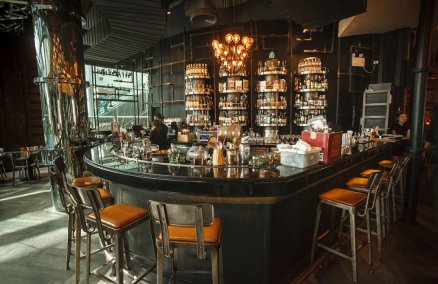The Cool Cat - Glen Goei, Theater Director
Stepping into esteemed theater director Glen Goei’s magnificent bachelor pad in High Street Centre overlooking the Old Parliament House, what strikes you first is the beautiful all-white interior with minimalist designer furnishing from the likes of Phillipe Starck. And then come the artworks, all 20 or so of them hung all over the apartment. Goei, who has been actively collecting since 2002, has one of the best and hippest collections around.
Situated in the main living room is an untitled sculpture by Anthony Poon that is a distorted red lipstick, and two major pieces from Singapore-based French artist Agathe de Bailliencourt, most well known for her graffiti-inspired scribbling infused with vibrant colors and strokes. Goei’s choice of de Bailliencourt pieces—“J’aime-J’aime Pas 14” and “J’aime-J’aime Pas 27”—are two of the most attractive and striking works from her first solo show J’aime, J’aime Pas at Taksu Gallery early last year, and a testament to his good taste.
Poon and de Baillencourt’s works aside, Goei is also an avid collector of artworks by Kumari Nahappan, husband and wife Milenko and Delia Prvacki, and the legendary Chua Ek Kay—all tastefully displayed in his second bedroom, study room and kitchen area. A large Milenko Prvacki work, in particular, resonates with its dream-like scribbling and pastel watercolor markings, as does Nahappan’s set of two paintings “Inside Outside and Space Between”—stare at them long enough and you will notice how trippy they can be—pretty cool stuff.
“I collect works of local artists or foreign artists who are based here,” states Goei. “It’s something about the themes and subject matter that I identify with…so you won’t see me collecting contemporary Chinese artworks anytime soon,” he adds with a little chuckle.
The Haute Collector - Dr. Woffles Wu, Plastic Surgeon
Walking through famed plastic surgeon Dr. Woffles Wu’s highly enviable private collection of contemporary artworks found in his lush home in Cluny Road, one can’t help but be awed by the amount of coveted pieces that the man owns. No surprise since Wu has been collecting since the ’80s, beginning with smaller sculptures and paintings from the world over by the likes of William Turnbull to European Surrealist works, to his impressive collection of mainly Chinese contemporaries acquired more recently. All the artworks are thoughtfully exhibited along the hallways, living room, dining room, pillars, and whatever wall space is available, making them very immediate and sometimes jaw-dropping, especially when viewed collectively.
Wu’s best collection can be found in the main dining area, where some of his personal favorites are displayed, including “Warhol Mao” by Chinese Yu Youhan, and a smorgasbord of sculptures and other intricate art trinkets. “The best pieces come out of suppression and subversion, which is why I really love the Chinese contemporaries,” states Wu. “They came out during a powerful moment…and they are darkly attractive for what they represent, especially the old Chinese sculptures that I found in my grandfather’s house. While some may not view these as artworks, I think otherwise. They are so expressive…as the sculptors who made these works had imbued them with such human spirit.”
The plethora of sculptures aside, Wu’s other noteworthy works are simply too many to list (certainly not a bad thing), sourced mainly from Shanghai and Beijing, where Wu makes frequent trips. There is political pop artist Wang Guangyi’s very hip series of silk-screens and paintings that appropriate the visual tropes of the propaganda of the Cultural Revolution, Yun Min Jun’s sculpture from his famed “smiling man” series, another Mao-influenced piece by Feng Zhengjie, and no less than a dozen pieces by local pop artist Justin Lee, whose artworks are perfect accompaniments to the cool Chinese contemporaries.
Needless to say, Wu’s collection is a million dollar investment worth calling the doctor for. “Basically, I just buy what I like…but I don’t collect for the sake of collecting. It’s a pop collection…with subject matters that truly resonate,” he states.
The Flag Bearer - Goh Choo Beng, Doctor
Dr. Goh Choo Beng’s collection may not be very extensive, but he can certainly lay claim to owning one of Singapore’s most sough-after the artworks in recent years. Increasingly revered local pop artist Justin Lee’s 2002 piece, “Flag,” which drew flak from the government when it was first shown (thus certifying it as a collector’s piece), has been in Goh’s possession over the past five years, and he won’t be parting with it anytime soon, despite many offers from private collectors and auction houses like Sotheby’s.
“Frankly, I don’t know the market value of the piece now, but it’s a piece that I very much would like to keep,” he states. Lee’s works are infused with quirky renderings of East-meets-West pop culture images, and it’s very easy to fall in love with them. “Flag” is no different. Look beyond its rather controversial main body and context, and you will notice wonderful details like the phoenix and dragon motifs spattered across the many layers of the Chinese characters “double happiness” repeated all over the piece.
“I’ve always been a fan of Chinois-inspired artworks and sculptures, and have been collecting ceramics, porcelain and wood carvings for the past 15 years or so,” he adds. Certainly, Lee’s “Flag” looks right at home with Choo’s other works at his home in Joo Chiat, alongside another Lee piece “I Love Mondrian,” an homage to the famed Dutch artist Piet Mondrian, and contemporary pieces by Filipinos Kiko Escora and Emmanuel Garibay. “I usually buy art works that have social messages...like Escora’s works, which deal with the sexual ambiguities of today’s society.”
It’s the fusion of the contemporary and not-so-contemporary that makes Goh’s collection tick—we were also rather impressed with his collection of rare Peranakan ceramics, sculptures, relics and even, an old window pane, retrieved from his family’s previous home—that are all displayed side by side. But it’s the brilliant “Flag” that stands out most among Goh’s collection. “Despite Lee’s many attempts to recreate the piece in many guises, it’s still this original piece, with its beautiful details and elaborate stencilling, that is the masterpiece."
The Art Connoisseur - Dr. Pwee Kheng Hock, Art Gallery Owner
Considering that Dr. Pwee Kheng Hock runs full-fledged art gallery Utterly Art, his collection of mainly younger, less established artists make his collection a standout and respectably progressive. Shunning big international names that are usually overpriced, Pwee prefers to go for younger, up-and-coming artists whose works may not necessarily be obvious masterpieces, but are interesting and make suitably conversational pieces.
Take, for example, a gorgeous lino cut by young Filipino artist Leonard Aguinaldo entitled “Dog Show: Prostitution of the Political Process,” a work from 2005 which comments on the Philippines’s corrupted political scene. The beautifully hand-painted piece made from lino cuts is one Pwee’s best pieces, and its sometimes shocking imagery of sexual decadence and sleaze makes it one of the most forward-thinking as well.
“I am fairly progressive in my collection, and am eclectic in the sense that I collect from a wide array of artists,” he states. Also noteworthy in Pwee’s collection of over 200 pieces, which can be found mainly in his store rooms at home and Utterly Art, are works by regional artists like Malaysians Jalaini Abu Hassan and Zulkifli Yusoff, Thai Tawatchai Somkong and Filipinos Kiko and Fernando Escora.
We especially like the slightly morbid “Family Portrait” by Singaporean Dang Xuan Hua, with its cynical depiction of today’s nuclear family (“I always call this my Addams Family piece,” quips Pwee), and Debasish Sarkar’s “Reminiscence,” with its simple and lucid black and white figurative rendering of the human condition.
“My collection emphasizes technique and impact, rather than having that showy factor. When a piece is good, it’s just good...doesn’t matter if it’s from an established artist or otherwise.”
The Design Conscious - Terence Chan, Architect
At first glance, the art collection by architect Terence Chan, which is displayed in his office space Studio Terre in Smith Street in Chinatown, may come across as boring or predictable. After all, Chan has only been collecting over the past year, amassing about 20 mostly monochromatic toned works that are purchased mainly as decorative pieces. But look closer, and there are rare gems to be found.
Never mind that Chan’s main pieces are mostly in black and white, including three large pieces by young contemporary Chinese artists Yeo Shih Yun, and photography by American Rodney Smith, and Singaporeans Alexander Ow and Tan Kheng Ju. Sprinkled throughout his office space are eye-catching and quirky works by a slew of up-and-coming artists as well, like a series of contemplative and haunting self-portraits by Singaporean Nicholas Chai, childlike drawings by young Singaporean Kherray and great pieces by Filipinos Maya Munoz, Jayson Oliveria and Elaine Roberto-Navas—the latter, whose depictions of the much loved Blythe dolls, are haunting and gorgeous all at the same time.
“Yes, while my collection is mostly monochromatic, there are also a few colorful pieces here and there,” Chan quips. Some of the more outstanding pieces here include the pastel-hued “Power,” a quietly penetrating portrait of a fellow artist by Maya Munoz, and a prized photography work “Don Jumping Over Haybale” by the famed Rodney Smith, whose surrealistic yet picture perfect images are intrepid interpretations of modern day fashion spreads. While Chan’s collection is mostly calculated, the pieces fit his uber cool Studio Terre perfectly, and are a sign of more things to come for this young collector.
Look out for three masterpieces at the Singapore Art Museum























